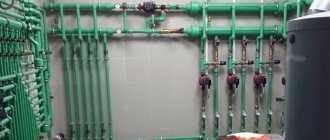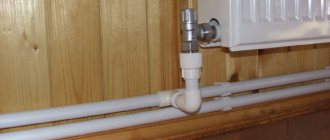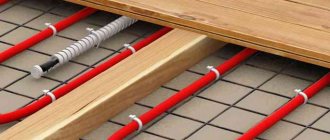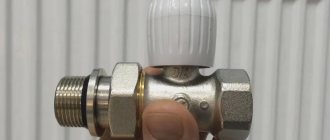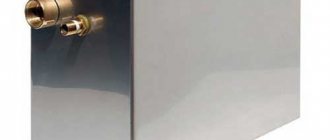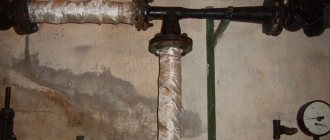It would be better to entrust the installation of a heating system to a private home to professionals, since they are already familiar with all the subtleties and nuances that can be encountered during installation. Our specialists will also help you with the choice of equipment and will be able to complete all the work on a turnkey basis. We contacted the AquaHit company to find out in more detail about heating schemes for a private home.
A private cottage that is not connected to the central heating main must be equipped with its own heating system. An autonomous heating system can be one-pipe or two-pipe. The first is more economical and easier to install, but less efficient in operation. More popular now is a two-pipe heating system for a two-story house, the design of which involves the parallel connection of all radiators and the presence of a return riser.
The difference between one and two-pipe heating schemes Source timber-ok.ru
What does the heating system consist of?
The main structural details of the heating system of a private house:
- radiator set;
- coolant – most often water, but it can be a gaseous medium or non-freezing liquid, depending on the type of boiler;
- boiler - electric, gas, solid fuel, diesel or kerosene;
- heat pipe.
The system has a closed principle of operation, that is, first the coolant is heated by the boiler, sent through a pipeline to the radiators, and then, cooled down, returned to the heat source. A set of heating devices together with a heat pipe is called a heating circuit.
The listed elements are enough to create a simple heating project for a two-story house. However, to increase the efficiency of autonomous heating, a few more details are added to the diagram:
- filter – needed to protect the boiler from clogging;
- pump – for forced circulation of coolant through pipes;
- safety devices (pressure relief valve, air vent, pressure gauge) - required in systems with forced circulation;
- expansion tank - collects excess coolant when it overheats and expands in volume.
This creates a heating scheme for a two-story house with forced circulation.
The heating system consists of many interconnected elements Source opechi.ru
Types of circulation pumps
Based on the specific operating conditions, pumps used in the heating system can only have a rotary vane design. In circulation compressors, the working part is a shaft with blades - by pumping liquid into the pipeline, they create increased pressure in it.
The circulation pump for heating systems can be of two types - the difference between them lies in the possibility of circulation of liquid inside their body. The design of pumps equipped with a dry rotor is the most advanced. The pumps have a reliable mechanical shaft seal, which prevents liquid from getting inside.
The only part in contact with the liquid is the seal. The disadvantages of such pumps include their relatively large size and rapid overheating, which is why they require an additional cooling system. Pumps with a dry rotor are more suitable for installation in industrial facilities.
If we touch on the issue of household heating systems, then, as a rule, they install models with a “wet” rotor, which are smaller in size.
Water in such systems freely penetrates inside the housing, performing the function of cooling the electric motor and lubricating moving parts. The disadvantage of “wet” type pumps is the rapid wear of parts, which reduces their service life.
Basic system requirements
There are a number of important requirements that must be taken into account when designing a heating system.
- In general, the heating design of a two-story house must correspond to the architectural design of the building. The placement of the boiler requires certain structural and design conditions of the room in which it will be located. The installation locations of radiators, as well as the pipeline routes, should not violate the architectural rules for the arrangement of residential and technical premises. All this means that a qualified designer must draw up a plan for the heating system, based on the finished architectural design of the house.
- During operation, the system must provide all internal and external surfaces with the temperature required by building codes and regulations (SNiPs).
- The system must be quite economical to operate. If heating your home requires too much energy consumption, you should contact a specialist: perhaps some parts or components can be unified.
- The pipeline should have a minimum of bends and turns. If during its installation you need a large number of fasteners in different sizes, it means that the heating circuit is poorly designed.
It is always necessary to draw up and evaluate a preliminary scheme Source tapiart.ru
- During use, the system must be reliable, safe, convenient and silent. A good system allows home owners to easily control heating appliances and, if necessary, easily repair them.
- The aesthetic side is also important. Radiators and pipes connected to them must have a neat, attractive appearance. The less noticeable the heating elements are, the better.
Selecting a circulation pump
As we have already found out, the main device in a heating system with forced circulation is the pump - which is why choosing it correctly is very important. To effectively heat a three-story house, the pump must first be correctly selected based on the area of the heated building.
Also important are such characteristics of the unit as reliability, long service life and economical energy consumption. When choosing a circulation pump for heating systems, you need to take into account the length of the pipeline; the material from which the pipes are made, as well as their diameter; number of heating devices and their type; type of equipment regulator.
With the correct ratio, mandatory consideration of these parameters and professional installation, the pump will serve you for a long time, eliminating the need to replace it and eliminating the possibility of unnecessary electricity consumption.
Designing a heating system for a two-story house
The heating system of a building in which there is more than one level must ensure that the coolant rises to the height of the floor. The heating connection diagram in a two-story private house can be with forced or natural circulation of coolant, with vertical or horizontal risers, with lower or upper wiring. And, of course, it may involve one-pipe or two-pipe wiring. Before choosing one or another type of heating system design, you need to familiarize yourself with the advantages and disadvantages of each of them.
See also: Catalog of companies that specialize in insulating country houses.
Natural coolant circulation
A distinctive feature of the scheme with natural coolant circulation is the placement of the system pipes at a slight angle to “help” the liquid flow from one part of the scheme to another.
System with natural coolant circulation - pipes are located at an angle Source strojdvor.ru
The natural or gravity heating scheme of a two-story house functions due to the fact that the liquid (coolant) expands when heated and its density decreases. In a loose state, it rises along the accelerating vertical section into the radiators of the second floor. After this, in a cooled, dense state, it flows down the pipeline and enters the boiler for further heating.
Natural circulation systems have their advantages :
- cost-effective installation;
- ease of installation and operation;
- absence of noise that occurs when the pump operates in forced systems;
- independence from power supply, but only if the boiler can operate without electricity supply;
- does not require frequent repairs, as it consists of simple elements.
Minuses:
- The natural circulation system has a very short range and is therefore not suitable for houses with an area of more than 100 square meters. meters.
- The system requires the mandatory installation of an expansion tank in the attic, which means that additional difficulties will arise when arranging heating on the residential roof floor - the attic.
The expansion tank in such a scheme must be installed at the top point of the system Source pinterest.co.uk
- When heating with natural circulation, rooms warm up very slowly. It may take several hours from the moment the boiler is started to completely warm up the distant rooms.
- In walk-through rooms where radiators are not installed, it is necessary to insulate the pipes, since in these places there is a risk of liquid freezing.
Choosing between electric and water heated floors
During operation, water and electric heated floors work with almost the same heat output, unless gross violations were committed during their installation. However, significant differences between these two systems lie in the cost of their installation and further operation.
During installation, you will have to spend much more money on a water heated floor than on laying an electrical circuit. However, the price of electricity is such that you will have to pay a lot for its use and constantly during the heating season.
In this regard, many consumers make the choice in favor of a water floor. It is best to choose to install a water-heated floor and radiators from one condensing-type boiler.
If we are talking about an apartment in a multi-storey building, then there may be problems connecting radiators and heated floors to one collector. But the total cost of installing the water circuit and its further operation will depend on the complexity of the system.
As for the electric floor, in an apartment, on the floor you can lay infrared film, carbon heating mats or two-core cables. The choice in this case depends entirely on the desires and financial capabilities of the apartment owner. The advantage of electric floors is their ease of installation.
Please note that heating efficiency is also affected by the type of pipe layout. If the house is large, then you should not save money - it is best to install a two-pipe system.
Forced circulation
In the case of forced circulation, the heating distribution from the boiler in a private two-story house is supplemented by a circulation pump, which drives the coolant through the pipes at the required speed. This is a more modern and efficient option for heating a building.
The forced heating scheme for a two-story private house has the following advantages:
- fast heating of all rooms;
- the ability to install pipes of minimal diameter;
- pipeline parts do not experience temperature changes and therefore last a long time;
- you can regulate the temperature in the house;
- You can adjust the temperature in each room separately.
The circulation pump is an obligatory part of the forced heating circuit. Source rookame.ru
A system with forced circulation also has its disadvantages :
- in a de-energized house, the system with a pump will not work;
- the pump consumes electricity, resulting in increased energy consumption at home;
- a running pump creates noise, which, however, with proper selection and installation of equipment, will be almost unnoticeable.
Single-pipe heating circuit
A single-pipe heating system for a two-story house, the design of which involves alternately connecting radiators to the pipeline, has the following advantages :
- minimal consumption of materials during installation;
- the ability to lay pipes where needed, even in the most inaccessible places;
- one pipe laid along the wall looks more aesthetically pleasing than two;
- quick and easy installation.
Among the disadvantages are the following features:
- if repair or replacement of any part of the system is required, the entire system must be stopped;
- heat spreads unevenly; the closer the room is to the boiler room, the higher the temperature in the radiators.
If parallel connection of convectors is used in single-pipe systems, this scheme is called “Leningradka” Source teplomirkr.ru
Heating pipe options
The heating system is not only a boiler and radiators, but also pipes through which the coolant moves under pressure. To install a heating junction for a private three-story house, you can use pipes from the following materials:
Related article: Sliding doors with photo printing for dressing rooms
House heating system diagram.
- steel pipes (galvanized, stainless). When installing such pipes, it is necessary to take into account that a welding machine is required for the connection. This material is durable and its service life is quite long. But there are also disadvantages, which include the need to use welding and experience working with metal threaded connections. Today, steel heating pipes are used less and less, as there are cheaper, but no less high-quality materials;
- Heating can also be carried out using copper pipelines, which today are considered the highest quality and most reliable. They can withstand high pressure and are not subject to corrosion, but the cost of such pipes is high; today they are used only for exclusive construction. For connection, special high-temperature soldering using silver is used. After work, all joints are carefully sealed;
- polymer pipes are a large group that includes polyethylene, metal-plastic, polypropylene with aluminum reinforcement. The products are easy to install, they are of high quality, some can be mounted inside the wall, which has a positive effect on the interior of the house. The heating system is installed quickly; various methods are used for connection, including pressing, the use of a special apparatus for welding, and temperature connection of pipes.
When choosing pipes, you need to take into account how complex the system will be, whether it is possible to lay the pipeline in the walls, and what requirements apply to the connections.
Selecting the optimal heating scheme
First, let's determine what type of heating system we need - with natural or forced circulation. If you have a large two-story cottage, then you definitely need to choose a system with a pump. But if you have a small dacha in an area remote from central highways, a gravity-flow system that can operate without electricity may be suitable for you.
Now let's choose between a single-pipe and a double-pipe option. If there are few rooms in the house, and the requirements for the aesthetics of the interior are high, it is better to install heating using a single-pipe system. But if there are many rooms, and the thermal conditions of individual rooms, for example children’s rooms, are of great importance to you, choose a two-pipe type of heating.
When making a final decision, it is important to remember that most homeowners prefer a two-pipe scheme with a forced operating principle
In what cases is combined heating installed?
The combined heating system performs well in houses of a wide variety of designs and purposes. If we consider a two-story building as an example, then the installed heated floors on the ground floor create a comfortable microclimate, heating the room. At the same time, the ceiling also warms up with warm air currents - it also serves as the floor for the rooms on the second floor. Radiators mounted on the second floor will heat the rooms, and the floor will not become a bridge of cold and a source of heat loss.
Ceramic tiles are best on top of a heated floor on the lower floor. But for the living room or bedroom it is better to choose a coating of a different texture. With the help of thermostats, you can easily control the floor temperature at your discretion.
Ideally, the possibility of creating combined heating should be included in the design of a multi-storey building under construction. However, in real conditions this is practically impossible due to many limitations. In particular, if the apartments will have central heating, then water heated floors cannot be installed in them. Although systems with heat exchangers have a right to life.
To install a water heated floor in an apartment, you will need to coordinate the project with the relevant organizations. In addition, it is important to choose the right flooring. For example, carpet or parquet, due to their thermal insulation properties, are not suitable for these purposes. The optimal materials are laminate and tile.
If you want to lay linoleum, it must be of very good quality. When heated, cheap material quickly deforms and begins to release toxic substances into the air, and this already threatens the health of residents.
As an option, high-rise apartments often use electric heated floors in conjunction with central heating radiators. In this case, it is important to take into account the load on the electrical wiring and draw a separate line for the heated floor directly from the electric meter.



